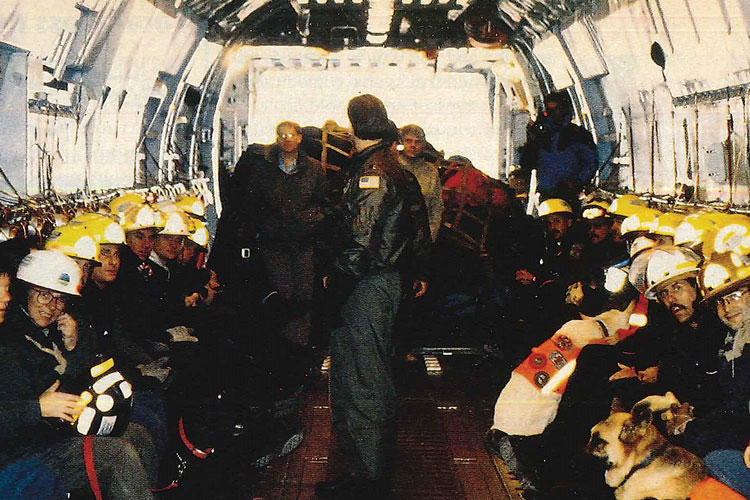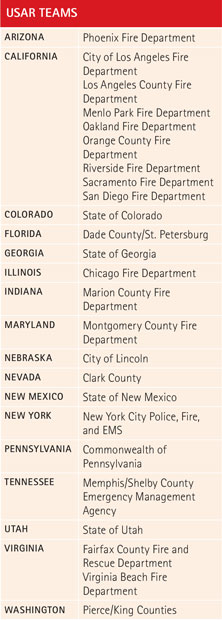
Training the Fire Service for 140 Years
US&R Teams, 1992: “An Almost Impossible Dream Realized”
By GLENN CORBETT
ince the Federal Emergency Management Agency (FEMA) organized the first urban search and rescue (US&R) teams in the 1990s, the effectiveness of these highly trained and fully equipped resources has been confirmed again and again. The communities devastated by Hurricane Andrew (1992); the Northridge, California, earthquake (1994); the Oklahoma City bombing of the Alfred P. Murrah Federal Building (1995); and others have all benefited from these teams’ response. In the years since, the program has expanded beyond the original teams listed below.
Legendary Fire Department of New York (FDNY) Deputy Chief Ray Downey is considered the “father” of the US&R program. His Fire Engineering articles traced the evolution of the rescue function and its many tools and techniques. Downey, along with several of the US&R teams he helped create, responded to the 9/11 terrorist attack on the World Trade Center. He was among the 343 FDNY firefighters who perished. (His bio at the time he wrote this article appears at the end.)
Download a PDF of the complete article at http://emberly.fireengineering.com/archives.html.
Fire Engineering, May 1992
National Urban Search and Rescue Network
BY RAY DOWNEY
In January 1990, the Federal Emergency Management Agency (FEMA) convened a workshop in Seattle, Washington, to address concerns – including the availability of resources within the United States – relative to conducting urban search and rescue (US&R) activities in the event of a catastrophe such as an earthquake, hurricane, tornado, or other natural disaster. Earthquakes in Mexico City, Armenia, and California have brought to the forefront the need for a national urban search and rescue network with the capabilities to provide personnel, equipment, and resources to accomplish the many varied tasks required during a major disaster. What at first seemed like an almost impossible dream was realized in September 1991 when 25 urban search and rescue teams in 17 states were chosen by FEMA to constitute the first national urban search and rescue network for catastrophic disasters.

Background/History
Teams deployed to assist at operations during the earthquakes in Mexico City, Soviet Armenia, and California did not have task forces such as those now available, but the many problems they had to overcome and the experience they gained provided the groundwork for the present system. When disasters such as earthquakes occur, the local available resources (manpower and equipment) quickly are overtaxed or in some instances become nonexistent – due mainly to the enormous devastation.
The first workshop, in Seattle, was attended by 85 invited participants representing all geographic regions of the country; all major areas of relevant technical expertise; and federal, state, local, and private-sector organizations. During the workshop, the emphasis was on the following:
- Discussing the status of the existing national US&R capabilities.
- Identifying requirements for a national US&R system.
- Identifying actions necessary to develop and implement a national US&R system. Discussing the present-day structure of intergovernmental relationships to facilitate the establishment and implementation of a national system.
[O]n September 26, 1991, FEMA [announced], “Twenty-five urban search and rescue teams in seventeen states have been chosen by the Federal Emergency Management Agency (FEMA) to constitute the first national urban search and rescue network for catastrophic disasters.”
Team Requirements
Teams are made up of 56 members and will be capable of operating on a 24-hour, around-the-clock basis. Team formation is designed to provide a continuous operation: Half the team works for 12 hours while the other half rests for 12 hours. Commitment of a team can last from seven to 10 days. The equipment cache includes sufficient personnel needs so that the teams are self-sufficient for up to 72 hours, after which the government will fulfill their needs.
A team is broken down into the following specialty categories:
- Task force leaders (2).
- Search team managers (2).
- Canine search specialists (4).
- Technical search specialists (2).
- Rescue team managers (2).
- Rescue squad officers (4).
- Rescue specialists (20).
- Medical team managers (2).
- Medical specialists (4).
- Technical team managers (2).
- Structure specialists (2).
- Hazardous-materials specialists (2).
- Heavy rigging and equipment specialists (2).
- Technical information specialists (2).
- Communications specialists (2).
- Logistics specialists (2).
Each one of these specialties has general and specific requirements and criteria with which team members must comply. General requirements include age, physical standards, availability, American Red Cross certification, ability to function for long hours under adverse conditions, and current inoculations; specific requirements include for, say, a rescue specialist a minimum of three years of regular field experience in rescue operations, proficiency in rope rescue techniques, proficiency in confined space rescue techniques, and a basic understanding of search unit strategy, tactics, techniques, and equipment. Each of the 16 positions has its own criteria; some require more than others.
The task force teams, on activation, are required to mobilize their personnel and equipment and to be at a predesignated point of departure within six hours. The Department of Defense will provide transportation to the site of the disaster, where teams will meet with the local incident command. Teams will be assigned an operational area where they will work with the local incident commander. (See box for a list of teams and their locations.)

Present Status
An orientation training course is being developed and in June 1992 will be presented to task force leaders, team managers, and state and local sponsoring agencies, including the relevant military representatives. The orientation programs will be held in six centrally selected areas of the country, where four to five teams will meet for a three-day training seminar. In addition, training programs for the teams are being developed to provide a uniform operating procedures system. The training working group is addressing the needs of these teams by reviewing available existing training programs and comparing program contents with the needs of the task force teams and developing a program to meet the needs of the response system.
A number of task force teams already have been involved in training exercises (initiated and sponsored on their own) to test readiness, mobilization, and operational procedures. The state of California has had a number of these exercises, one of which included teams from various areas of the state in an operational exercise and another including a mobilization and airlift from Los Angeles to San Francisco (see “Operation Air Bridge,” Fire Engineering, December 1991).
California has strong competition in the East from Fairfax County (VA) Fire and Rescue, Montgomery County (MD) Fire and Rescue, and the Virginia Beach (VA) Fire Department, who have been meeting, training, and “networking” for the FEMA urban search and rescue response program. This past January, Fairfax County and Montgomery County participated in a day-long exercise simulating activation, mobilization, and response from Andrews Air Force Base. The exercise included team call-out, mobilization, transportation to the site of departure, and equipment packaging and loading onto an aircraft. Military personnel held group discussions with task force team members, explaining the requirements for an airlift in such a short time frame. These are just some of the first steps in this major undertaking by FEMA and the task force teams to coordinate the US&R response system.
RAY DOWNEY, a captain and 30-year veteran of the City of New York Fire Department, has commanded the operations of its Rescue Co. 2 for the past 12 years. He has an associate degree in fire science and is a New York state certified instructor. He conducts seminars and gives lectures on rescue-related tactics throughout the United States. Downey is a member of FEMA’s US&R working group for equipment and Technical Review Panel. He is the author of The Rescue Company, published by Fire Engineering Books.
Fire Engineering Archives

